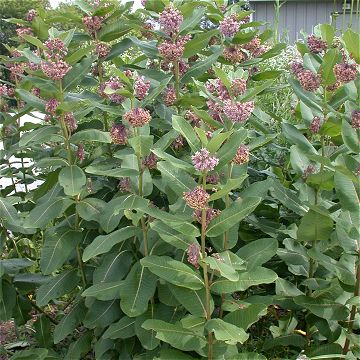

Asclepias syriaca - (image 1 of 6)
Taxonomy
Family: Asclepiadaceae
Habitat
Open, disturbed sites. Prairies, dunes, roadsides and fields.
Associates
Distribution
New Brunswick south to VA and northern GA, west to Manitoba, NE, and OK..
Morphology
Coarse perennial, often more than 60 cm tall. Leaves variable but often elliptic, oblong, or obovate, short petiolate, somewhat pubescent. Flowers in multiple umbels, salmon to pink; reflexed corolla lobes over 5 mm, longer than corona hoods. Fruit a robust, warty, follicle.
Notes
Flowers June to August
Wetland Indicator: Upland
This plant seems perfectly natural on open dunes, where it grows singularly or in small colonies; not the dominant weed often seen along roadsides or adjacent to parking lots and fields. Host to many bugs that are black and orange, presumably a trait which serves as a warning to predators. Contains cardiac glycosides but the sap is very bitter and therefore unlikely to be ingested. Pods and young shoots are sometimes included in edible plant guides, with the claim that boiling in several changes of water removes the toxic properties.
References
Foster, S. and R.A. Caras. 1994. A Field Guide to Venomous Animals and Poisonous Plants: North America North of Mexico.
Houghton Mifflin Company. New York, NY. 244 pp.
Gleason, Henry A.
and A. Cronquist. 1991. Manual of Vascular Plants of Northeastern United States
and Adjacent Canada. Second Ed.
The New York Botanical Garden. Bronx, NY
Peterson, L. A. 1977. A Field Guide to Edible Wild Plants: Eastern and central North America.
Houghton Mifflin Company. New York, NY
Swink, F. and G.
Wilhelm. 1994. Plants of the Chicago Region.
Indiana Academy of Science. The Morton Arboretum. Lisle, Illinois.
|
© Michael Hough 2004 |